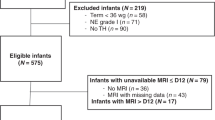Abstract
Background. Newborn infants are particularly prone to hypothermia, a condition with a high mortality. Objective. To study the CT brain patterns in infants with hypothermia and neurological symptoms. Materials and methods. We reviewed the brain CT of nine infants with neonatal hypothermia, multiple organ failure, seizures and coma. Results. Two infants had normal CT scans, acutely and at follow-up, and were clinically normal at follow-up. In seven infants, CT showed diffuse cerebral oedema, with reversal of the normal density relationship between grey and white matter and a relative increased density of the thalami, brainstem and cerebellum – the ’reversal sign'. In six surviving infants with severe developmental delay, follow-up CT revealed cerebral atrophy with multicystic encephalomalacia. Conclusions. The ’reversal sign' has been described in the abused child, birth asphyxia and anoxia due to drowning. Neonatal hypothermia is offered as a further cause.
Similar content being viewed by others
Author information
Authors and Affiliations
Additional information
Received: 18 September 1997 Accepted: 3 December 1997
Rights and permissions
About this article
Cite this article
Schulman, H., Laufer, L., Berginer, J. et al. CT findings in neonatal hypothermia. Pediatric Radiology 28, 414–417 (1998). https://doi.org/10.1007/s002470050373
Issue Date:
DOI: https://doi.org/10.1007/s002470050373



